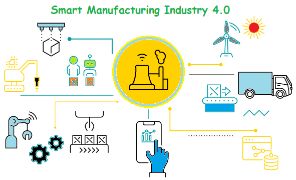Introduction
The Revolution of Smart Factory Industry 4.0 is transforming the manufacturing landscape, revolutionizing the way factories operate and bringing a new era of automation and connectivity. This fourth industrial revolution encompasses cutting-edge technologies such as the Internet of Things (IoT), artificial intelligence (AI), robotics, cloud computing, and big data analytics. It represents a paradigm shift in manufacturing processes, enabling companies to achieve greater efficiency, productivity, and flexibility in their operations.
The Benefits of Smart Factory Industry 4.0
Smart Factory Industry 4.0 brings numerous benefits to manufacturers across various sectors. One of the key advantages is increased operational efficiency. Through interconnected systems and real-time data exchange, factories can optimize their processes, reduce waste, and improve resource utilization. Smart factories also enable predictive maintenance, allowing companies to identify potential issues before they cause major disruptions, thereby minimizing downtime and saving costs.
Another significant benefit is enhanced productivity. Automation and robotics streamline production lines, enabling faster and more accurate manufacturing processes. This leads to higher output and improved product quality. Additionally, smart factories offer greater flexibility by enabling rapid reconfiguration of production lines to accommodate changing demands and customization requirements.
Data plays a crucial role in smart factories. By leveraging big data analytics and AI algorithms, manufacturers can gain valuable insights into their operations, identifying patterns, optimizing supply chains, and making data-driven decisions. This leads to better demand forecasting, improved inventory management, and reduced operational risks.
Key Technologies Driving Smart Factories

Several transformative technologies underpin the revolution of smart factory Industry 4.0. The Internet of Things (IoT) connects various devices and sensors across the factory floor, facilitating real-time data collection and communication. This enables seamless coordination between machines, systems, and personnel, leading to improved process visibility, control, and automation.
Artificial Intelligence (AI) plays a vital role in smart factories. Machine learning algorithms and AI-powered systems enable autonomous decision-making, predictive analytics, and cognitive capabilities. AI enhances the efficiency of quality control, enables predictive maintenance, and optimizes production planning.
Robotics is another key technology in smart manufacturing. Collaborative robots, also known as cobots, work alongside human workers, automating repetitive tasks, reducing human errors, and improving safety. These robots can be easily reprogrammed and deployed in various tasks, enhancing flexibility and adaptability on the production floor.
Cloud computing and edge computing provide the infrastructure to store and process vast amounts of data generated by smart factories. Cloud-based platforms offer scalable storage and computational power, enabling real-time data analysis and facilitating remote monitoring and management of factory operations. Edge computing brings computation and data storage closer to the devices and sensors on the factory floor, reducing latency and enabling faster decision-making.
Conclusion
In conclusion, Smart Factory Industry 4.0 is revolutionizing the manufacturing landscape by harnessing advanced technologies to optimize efficiency, productivity, and quality. The integration of IoT, AI, and robotics in smart factories offers a range of benefits, including enhanced efficiency, improved quality control, agile production capabilities, cost reduction, and increased workplace safety. However, there are challenges to overcome, such as data security, workforce adaptation, and the initial cost of implementation.

